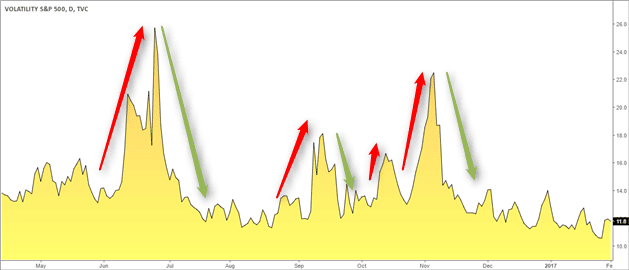For some, trading comes down to indicators, stock screeners, and economic reports.
Very few traders elevate their game enough to realize the vital importance of sound mental health. In this article, we are going to touch on a number of topics related to day trading psychology and how you can use these tools to stay in control of the game.
One of the toughest things to master when day trading is patience. [1] Once the market opens you will see the level 2 flashing green and red and alerts going off.
If you are not coming from a place of discipline, the market has a way of sucking you into trades without your consent. I know, you are pulling the trigger, but it’s almost like the market places a trance over you and you find yourself jumping into trades too soon.
You have to find a method for viewing all of the action, yet not taking any action until the perfect setup materializes.
A real test for you is to look at your last three months of trading data and see if you can find one day where you did not place a trade.
If you can’t find one day, then you are likely forcing the issue.
#2 – Understand the Herd

Zombie
Have you ever watched the show The Walking Dead? Well in the show there are these herds, which are mobs of zombies that move in unison as they march towards their next human meal.
It’s sad to say, but traders are no better than these mindless creatures at times.
As a trader, you need to be able to recognize the emotions of other traders on a macro level. These emotions can present themselves in the form of fear and greed (which we touch upon next) and are illustrated on the chart. I just wrote a piece on two penny stock chart patterns which walkthrough in detail the boom and bust cycle from the morning session.
Just remember a group of human beings can remain insanely bullish longer than the sell signal you are getting from your Williams %R indicator.
Learn to feel the mood of the herd in addition to understanding the technical setups.
#3 – Understand the Psychology of Fear and Greed
Fear in the stock markets is when investors shun risk and seek safety in assets with low yields. The general thinking here being that the investor is too afraid to invest their money for fear that they would end up losing their capital rather than make any profits.
Fear can also show up as investors just panic sell even if the stock is well below fair value.

Fear and Green Cycles as seen in the CBOE Volatility Index
Greed in the stock markets, on the other hand, is when investors seek higher returns irrespective of the risk. This means they are just buying into a position or using too much leverage in hopes of making huge returns.
These emotions occur in the broad market but also can creep up on you as an individual trader.
Greed
The thing not discussed is what happens to you mentally after greed or fear grabs ahold of you.
If you have been demonstrating greedy behavior and winning, this is likely the most dangerous combination. This will push you to trade with size and with little to no care. What do you think will happen? That’s right, a blow-up trade.
Fear
Fear is the exact opposite, where it exhibits itself in your ability to execute trades. [2] This can be in the form of not taking a position or unable to close a losing position.
How to Combat these Emotions

Meditation
The one cure for these two emotions is meditation and lots of it. There is no getting away from these two, so please don’t tell yourself you have everything under control.
#4 – Cut the Screens Off
Are you done trading for the day? If yes, then cut your screens off. The sheer fatigue of trading all day long can hurt your performance and your spirit.
Take time to go outside and breathe in the fresh air. Pick up a hobby, but most importantly cut the screens off.
#5 – Avoid the Big Blow Up Days

Explosion
If you are new to trading, do not worry about how much money you can make. Simply focus on not having big losing trades and big losing days.
Beyond the money, the psychological impact can last well beyond the closing bell.
So, look at each trade first on how much you can lose versus how much you can make.
#6 – Do Not Add to Losing Positions [3]
There are times in the past where I have purchased a breakout and the stock rolls over. So, what I thought was a breakout now becomes a pullback trade.
I should first honor my stop and if the stop is not hit, sell the stock out near my entry to minimize my risk.
But did I do this? Nope. I would wait for the next support level down or for some panic to kick-in and then double my position.
Now, there are times where the stock gets back to my original entry point and I’m up huge.
Then there are other times where I just breakeven on the trade.
Both of these make me feel like I am toying with the market.
But then the inevitable happens. The stock continues lower and a small manageable loss becomes a life-changing event.
How Can Tradingsim Help?
If you are actively involved in the markets day trading psychology is paramount to your success. Notice I didn’t just say trading psychology. Day trading is another beast altogether and it requires a different mindset. You have to come dressed and ready to play each and every day.
You can practice these hacks and more within Tradingsim to ensure you are able to keep a firm hand on your emotions while learning how to trade.
Image Credit
Image by Enrique Meseguer from Pixabay
Image by OpenClipart-Vectors from Pixabay
External References
- Fred. How to Be Patient in Trading. Lone Stock Trader
- Dr. Payton, Gary. Overcome Fear. tradingpsychologyedge.com
- Bennett, Justin. (2015). Never, Ever, Ever Add to A Losing Position. dailypriceaction.com











 Awesome Day Trading Strategies
Awesome Day Trading Strategies 
